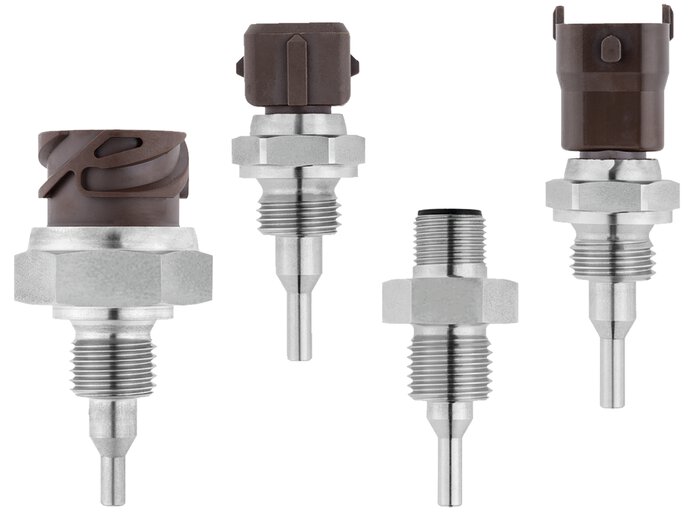

Sensors for heat pumps - temperature, pressure, flow
In the field of heat pump engineering, details play an extremely important role. It is the temperature, pressure and flow sensors that are those small but crucial components that determine the performance, energy efficiency and reliability of these systems. In this article, we take a deeper look at the function and role of sensors in heat pumps, discussing the key challenges and engineering considerations involved. Read on and improve the performance of heat pump systems through the optimal use of measuring sensors!
How does a heat pump work?
Heat pumps/air conditioners work by flowing refrigerant between the indoor and outdoor units. The refrigerant is heated and evaporates in the indoor unit and then gives off heat to the outdoor unit, returning to a liquid state. This cycle makes room cooling possible. In addition, between seasons, air conditioners can also act as a heat pump, which helps reduce heating costs. Thus, air conditioners are versatile devices that provide thermal comfort and can contribute to energy savings.
Types of heat pumps
Depending on the type of heat source, heat pumps are divided into: air source (which extract heat from the air), water source (which extract heat from ground water or bodies of water), ground source (which extract heat from the soil). All types of heat pumps work on the same principle, but differ in efficiency and installation costs.

Heat pump diagram
Heat pump temperature sensors
Temperature sensors are a key component in heat pumps, as they enable precise monitoring and control of the temperature throughout the system. JUMO offers two types of temperature sensors that can be used in heat pumps.
-
Plug-in resistance temperature sensor for heat pump - JUMO VIBROtemp resistance temperature sensor is resistant to vibration and oscillation, which is important for heat pumps that often operate in dynamic conditions

Plug-in resistance temperature sensors for heat pumps
Why does a heat pump freeze?
A heat pump can freeze for several reasons. The most common are:
- Low ambient temperature: In air heat pumps, if the air temperature is too low, freezing can occur on the outdoor heat exchanger. In water or ground source heat pumps, low water or soil temperatures can cause internal components to freeze.
- Lack of adequate insulation: If a heat pump is not properly insulated, heat loss can occur, leading to lower temperatures inside. This, in turn, can result in the freezing of various components, such as piping, sensors or heat exchangers.
- Improper system regulation: For example, if the temperature of the medium is set too low, it can cause the cooling liquid inside the heat pump to reach freezing point and form an ice block.
- Insufficient refrigerant flow: If the refrigerant flow in the heat pump is restricted or disturbed, it can lead to freezing. Insufficient flow causes the refrigerant liquid to stagnate, which increases the risk of freezing.
How to protect the heat pump from freezing?
To prevent the heat pump from freezing, it is important to take appropriate precautions. Here are some recommendations:
- Adequate insulation: Make sure the heat pump is well insulated to reduce heat loss and maintain the right temperature inside.
- Proper system adjustment: Make sure the heat pump system is properly calibrated and adjusted to the outside conditions to prevent the medium temperature from getting too low.
- Regular maintenance: Perform regular inspections and maintenance on the heat pump to monitor its condition
- Antifreeze thermostat: Install an antifreeze thermostat to automatically turn on the heat pump when the temperature reaches dangerously low levels. We will elaborate on this topic in the next paragraph.
Anti-freeze thermostat for heat pump
To protect the heat pump from freezing, it is necessary to use a suitable thermostat. A thermostat for a heat pump controls the temperature of the water or refrigerant it circulates inside the unit. When the temperature drops below a certain level, the thermostat turns on the heat pump to prevent it from freezing.
The JUMO frostTHERM-AT was designed specifically for this purpose. It has a specially designed part of the capillary line with a length of 30 cm, which is located above the outdoor unit of the air conditioner. When the temperature on this part reaches a certain point, the thermostat activates the heater or shuts down the entire system. This prevents the formation of condensation and protects the unit from frost damage.

JUMO frostTHERM-AT antifreeze thermostat
What pressure in the heat pump? JUMO pressure transmitters
The appropriate pressure for a heat pump depends on the specific model and specifications of the device. Typically, manufacturers provide recommended pressure values for their heat pumps. For example, for air-to-water heat pumps, the operating pressure can range from about 1.5 to 4 bar. In contrast, for ground-to-water or water-to-water heat pumps, the pressure can range from 2 to 6 bar.
However, it is always worth consulting the user's manual or the manufacturer to know the exact pressure values for a particular heat pump. It is important to keep the pressure within the correct range, as too low or too high a pressure can lead to performance and safety problems with the heat pump. Pressure transducers, such as the JUMO MIDAS S06, are necessary to accurately monitor and maintain the correct pressure in the heat pump.
Comments
Please leave your comments through the form listed below. Your comments will be placed online after they have been approved through our pending process


